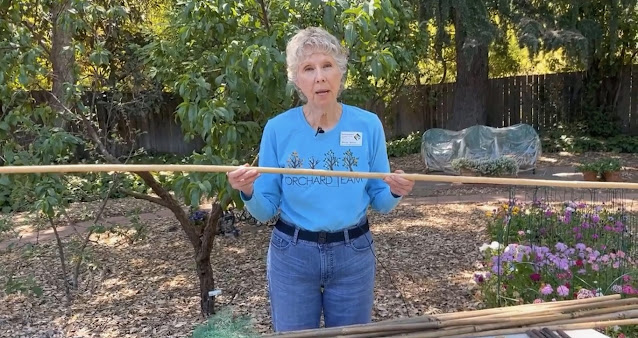
Master gardeners talk fruit protection, straw bales and more

|
|
UCCE master gardener Wendy Wilson explains the simple tools needed to net a fruit tree. (Screengrab from Sacramento County master gardeners YouTube channel)
|
Have you checked out the Sacramento County master gardeners' YouTube channel lately? Four new videos have been added to the 30 already there. They each tackle an important gardening question for this time of year
1) Netting Fruit Trees: An Easy and Inexpensive Method. Are the birds and squirrels eyeing your ripening tree crop? Master gardener Wendy Wilson demonstrates how to protect the fruit, on a 7-foot-tall cherry tree. (The master gardener Orchard Team recommends keeping fruit trees to this height for ease of picking and maintenance.)
2) Straw Bale Gardening, Part 1: Preparing the Bales. Master gardener Gail Pothour has been setting up straw bale gardens at the Fair Oaks Horticulture Center for a number of years, growing everything from sweet potatoes to tomatoes in them. She takes viewers through the process of conditioning the straw bales. Great information on the difference between hay and straw, too. Here's the printed guide she mentions in the video. A second video is planned on planting and growing in the bales.
3) Blueberries: Amending Your Soil's pH. Blueberries are picky about their soil -- they need a pH level of 4.5 to 5.5, which is acidic. Master gardener Marta Kravech explains why and how to get the soil acidic enough for blueberries to perform their best.
4) Maintaining a Weed-Free Lawn. Master gardener Sherry Dunn discusses the most common lawn weeds, plus offers mowing tips and information on herbicides.
The previously posted master gardener videos on YouTube contain a wealth of gardening tips. Here are 3 that are relevant right now:
-- Thinning Fruit on Your Fruit Trees. Thinning keeps fruit trees healthy and prevents breakage of limbs.
-- What's Wrong With My Tomatoes? This video tackles environmental disorders such as catfacing, blossom end rot, cracking and sunscald.
-- Harvest and Rejuvenate Your Lavender. Ruth Ostroff and Vivian Sellers of the master gardeners' Herb Team show the best way to keep lavender healthy.
-- Kathy Morrison
Comments
0 comments have been posted.Sacramento Digs Gardening to your inbox.
Sites We Like
Garden Checklist for week of May 12
Get your gardening chores and irrigation done early in the day before temperatures rise.
* Plant, plant, plant! It’s prime planting season in the Sacramento area. Time to set out those tomato transplants along with peppers and eggplants. Pinch off any flowers on new transplants to make them concentrate on establishing roots instead of setting premature fruit.
* Direct-seed melons, cucumbers, summer squash, corn, radishes, pumpkins and annual herbs such as basil.
* Harvest cabbage, lettuce, peas and green onions. This heat will cause leafy greens and onions to flower; pick them before they bolt.
* In the flower garden, direct-seed sunflowers, cosmos, salvia, zinnias, marigolds, celosia and asters.
* Plant dahlia tubers. Other perennials to set out include verbena, coreopsis, coneflower and astilbe.
* Transplant petunias, marigolds and perennial flowers such as astilbe, columbine, coneflowers, coreopsis, dahlias, rudbeckia and verbena.
* Keep an eye out for slugs, snails, earwigs and aphids that want to dine on tender new growth.
* Feed summer bloomers with a balanced fertilizer.
* For continued bloom, cut off spent flowers on roses as well as other flowering plants.
* Got fruit trees? If you haven't already done so, thin orchard fruit such as apples, peaches, pears, pluots and plums before they grow too heavy, breaking branches or even splitting the tree. Leave the largest fruit on the branch, culling the smaller ones, and allow for 5 to 6 inches (or a hand's worth) between each fruit.
* Thin grape bunches, again leaving about 6 inches between them. For the remaining bunches, prune off the "tail" end, about the bottom third of the bunch, so that the plant's energy is concentrated in the fruit closest to the branch.
* As spring-flowering shrubs finish blooming, give them a little pruning to shape them, removing old and dead wood. Lightly trim azaleas, fuchsias and marguerites for bushier plants.
* Add mulch to the garden to help keep that precious water from evaporating. Mulch also cuts down on weeds. But don’t let it mound around the stems or trunks of trees or shrubs. Leave about a 6-inch to 1-foot circle to avoid crown rot or other problems.